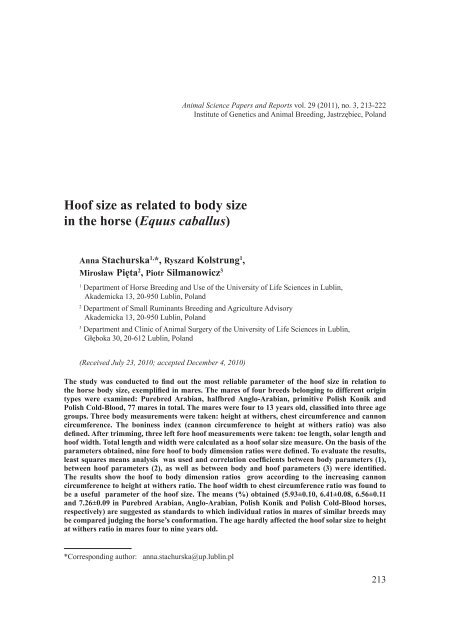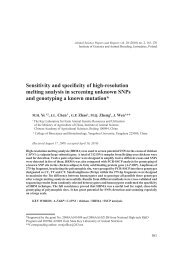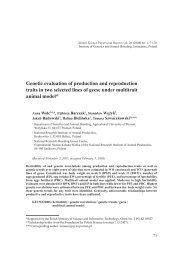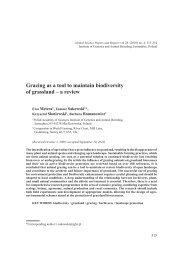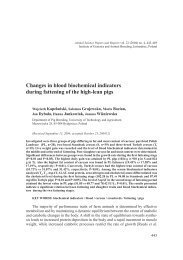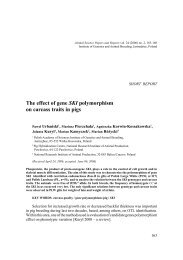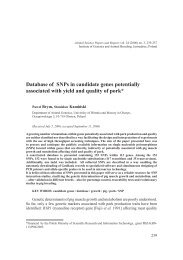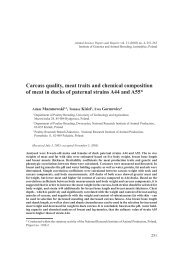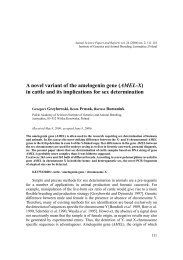Hoof size as related to body size in the horse (Equus caballus)
Hoof size as related to body size in the horse (Equus caballus)
Hoof size as related to body size in the horse (Equus caballus)
Create successful ePaper yourself
Turn your PDF publications into a flip-book with our unique Google optimized e-Paper software.
Animal Science Papers and Reports vol. 29 (2011), no. 3, 213-222<br />
Institute of Genetics and Animal Breed<strong>in</strong>g, J<strong>as</strong>trzębiec, Poland<br />
<strong>Hoof</strong> <strong>size</strong> <strong>as</strong> <strong>related</strong> <strong>to</strong> <strong>body</strong> <strong>size</strong><br />
<strong>in</strong> <strong>the</strong> <strong>horse</strong> (<strong>Equus</strong> <strong>caballus</strong>)<br />
Anna Stachurska 1, *, Ryszard Kolstrung 1 ,<br />
Mirosław Pięta 2 , Piotr Silmanowicz 3<br />
1<br />
Department of Horse Breed<strong>in</strong>g and Use of <strong>the</strong> University of Life Sciences <strong>in</strong> Lubl<strong>in</strong>,<br />
Akademicka 13, 20-950 Lubl<strong>in</strong>, Poland<br />
2<br />
Department of Small Rum<strong>in</strong>ants Breed<strong>in</strong>g and Agriculture Advisory<br />
Akademicka 13, 20-950 Lubl<strong>in</strong>, Poland<br />
3<br />
Department and Cl<strong>in</strong>ic of Animal Surgery of <strong>the</strong> University of Life Sciences <strong>in</strong> Lubl<strong>in</strong>,<br />
Głęboka 30, 20-612 Lubl<strong>in</strong>, Poland<br />
(Received July 23, 2010; accepted December 4, 2010)<br />
The study w<strong>as</strong> conducted <strong>to</strong> f<strong>in</strong>d out <strong>the</strong> most reliable parameter of <strong>the</strong> hoof <strong>size</strong> <strong>in</strong> relation <strong>to</strong><br />
<strong>the</strong> <strong>horse</strong> <strong>body</strong> <strong>size</strong>, exemplified <strong>in</strong> mares. The mares of four breeds belong<strong>in</strong>g <strong>to</strong> different orig<strong>in</strong><br />
types were exam<strong>in</strong>ed: Purebred Arabian, halfbred Anglo-Arabian, primitive Polish Konik and<br />
Polish Cold-Blood, 77 mares <strong>in</strong> <strong>to</strong>tal. The mares were four <strong>to</strong> 13 years old, cl<strong>as</strong>sified <strong>in</strong><strong>to</strong> three age<br />
groups. Three <strong>body</strong> me<strong>as</strong>urements were taken: height at wi<strong>the</strong>rs, chest circumference and cannon<br />
circumference. The bon<strong>in</strong>ess <strong>in</strong>dex (cannon circumference <strong>to</strong> height at wi<strong>the</strong>rs ratio) w<strong>as</strong> also<br />
def<strong>in</strong>ed. After trimm<strong>in</strong>g, three left fore hoof me<strong>as</strong>urements were taken: <strong>to</strong>e length, solar length and<br />
hoof width. Total length and width were calculated <strong>as</strong> a hoof solar <strong>size</strong> me<strong>as</strong>ure. On <strong>the</strong> b<strong>as</strong>is of <strong>the</strong><br />
parameters obta<strong>in</strong>ed, n<strong>in</strong>e fore hoof <strong>to</strong> <strong>body</strong> dimension ratios were def<strong>in</strong>ed. To evaluate <strong>the</strong> results,<br />
le<strong>as</strong>t squares means analysis w<strong>as</strong> used and correlation coefficients between <strong>body</strong> parameters (1),<br />
between hoof parameters (2), <strong>as</strong> well <strong>as</strong> between <strong>body</strong> and hoof parameters (3) were identified.<br />
The results show <strong>the</strong> hoof <strong>to</strong> <strong>body</strong> dimension ratios grow accord<strong>in</strong>g <strong>to</strong> <strong>the</strong> <strong>in</strong>cre<strong>as</strong><strong>in</strong>g cannon<br />
circumference <strong>to</strong> height at wi<strong>the</strong>rs ratio. The hoof width <strong>to</strong> chest circumference ratio w<strong>as</strong> found <strong>to</strong><br />
be a useful parameter of <strong>the</strong> hoof <strong>size</strong>. The means (%) obta<strong>in</strong>ed (5.93±0.10, 6.41±0.08, 6.56±0.11<br />
and 7.26±0.09 <strong>in</strong> Purebred Arabian, Anglo-Arabian, Polish Konik and Polish Cold-Blood <strong>horse</strong>s,<br />
respectively) are suggested <strong>as</strong> standards <strong>to</strong> which <strong>in</strong>dividual ratios <strong>in</strong> mares of similar breeds may<br />
be compared judg<strong>in</strong>g <strong>the</strong> <strong>horse</strong>’s conformation. The age hardly affected <strong>the</strong> hoof solar <strong>size</strong> <strong>to</strong> height<br />
at wi<strong>the</strong>rs ratio <strong>in</strong> mares four <strong>to</strong> n<strong>in</strong>e years old.<br />
*Correspond<strong>in</strong>g author: anna.stachurska@up.lubl<strong>in</strong>.pl<br />
213
A. Stachurska et al.<br />
214<br />
KEY WORDS: <strong>body</strong> dimensions / fore hoof / hoof dimensions / <strong>horse</strong> <strong>size</strong><br />
The hoof <strong>size</strong> is <strong>in</strong>fluenced, apart from genetic fac<strong>to</strong>rs, by many environmental<br />
effects, of which nutrition is <strong>the</strong> most important. It h<strong>as</strong> been documented that weanl<strong>in</strong>gs<br />
fed ad libitum with balanced ration had bigger hoof sole border than those which had<br />
limited access <strong>to</strong> <strong>the</strong> same feed [Butler and H<strong>in</strong>tz 1977]. Heritability coefficient of hoof<br />
conformation traits ranges from 0.16 for heel height <strong>to</strong> 0.27 for hoof shape [Ducro et<br />
al. 2009a]. Normal function<strong>in</strong>g of <strong>the</strong> hoof depends <strong>to</strong> a large degree on its <strong>size</strong>. The<br />
hoof should be a strong support for <strong>the</strong> <strong>horse</strong>’s <strong>body</strong> m<strong>as</strong>s. Thanks <strong>to</strong> <strong>the</strong> concave<br />
sole, wedge-shaped frog and <strong>the</strong> sharp-angled <strong>to</strong>e, it reduces slipp<strong>in</strong>g. The hard hoof<br />
capsule protects soft <strong>in</strong>ner structures. Concussion forces occurr<strong>in</strong>g dur<strong>in</strong>g movement,<br />
particularly high <strong>in</strong> f<strong>as</strong>t gaits and jumps on hard surface, are reduced by <strong>the</strong> el<strong>as</strong>tic<br />
structures <strong>in</strong> <strong>the</strong> hoof. A <strong>to</strong>o small hoof is not able <strong>to</strong> fulfill <strong>the</strong>se functions effectively<br />
and contributes <strong>to</strong> foot lameness [Redden 1997]. The rider considerably <strong>in</strong>cre<strong>as</strong>es <strong>the</strong><br />
natural fore hoof stra<strong>in</strong> and concussion <strong>in</strong> <strong>the</strong> movement [Clay<strong>to</strong>n 1997, Summerly<br />
et al. 1998, Clay<strong>to</strong>n et al. 1999]. Draught use of <strong>the</strong> <strong>horse</strong> additionally loads <strong>the</strong><br />
hooves, <strong>as</strong> well. The relation between <strong>the</strong> foot conformation and sport performance or<br />
movement traits is po<strong>in</strong>ted out <strong>in</strong> <strong>the</strong> recent publications by Ducro et al. [2009 ab] and<br />
van Heel et al. [2010]. However, <strong>the</strong> importance of <strong>the</strong> <strong>size</strong> of <strong>the</strong> hoof h<strong>as</strong> not been<br />
<strong>in</strong>vestigated extensively.<br />
Despite all <strong>the</strong> arguments for big hooves, <strong>in</strong> some breeds <strong>the</strong>y were once considered<br />
<strong>as</strong> <strong>in</strong>correct. Accord<strong>in</strong>g <strong>to</strong> Butler [1995], some American breeds were even selected<br />
for small feet for aes<strong>the</strong>tic re<strong>as</strong>ons. On <strong>the</strong> o<strong>the</strong>r hand, <strong>in</strong> many breeds <strong>the</strong> hoof <strong>size</strong><br />
is not <strong>the</strong> official selection criterion (e.g. <strong>in</strong> Poland) and that is <strong>the</strong> re<strong>as</strong>on for which<br />
<strong>the</strong> small hooves appear more frequently <strong>in</strong> <strong>the</strong> population. Instead, <strong>in</strong> show <strong>horse</strong><br />
breeds <strong>the</strong>re is a tendency <strong>to</strong> leng<strong>the</strong>n <strong>the</strong> hooves <strong>to</strong> achieve fl<strong>as</strong>hy gaits. It h<strong>as</strong> been<br />
documented that leng<strong>the</strong>n<strong>in</strong>g of <strong>the</strong> hoof <strong>in</strong>cre<strong>as</strong>es <strong>the</strong> maximum height of <strong>the</strong> hoof <strong>in</strong><br />
<strong>the</strong> flight, <strong>in</strong>cre<strong>as</strong>es <strong>the</strong> vertical velocity of <strong>the</strong> hoof and delays <strong>the</strong> breakover [Balch<br />
et al. 1994]. Some breed and show <strong>as</strong>sociations specify <strong>the</strong> maximum hoof length<br />
(me<strong>as</strong>ured on <strong>the</strong> dorsum of <strong>the</strong> front wall) with regard <strong>to</strong> <strong>the</strong> <strong>horse</strong> <strong>body</strong> weight <strong>to</strong><br />
prevent <strong>horse</strong> abuse [Lessiter 1996]. However, it does not concern <strong>the</strong> natural <strong>size</strong> of<br />
<strong>the</strong> capsule but <strong>the</strong> method of trimm<strong>in</strong>g.<br />
Apart from <strong>the</strong> length, <strong>the</strong> hoof <strong>size</strong> is usually judged subjectively. There is no<br />
commonly <strong>as</strong>sumed parameter which would show univocally whe<strong>the</strong>r <strong>the</strong> hoof is big<br />
or small relative <strong>to</strong> <strong>the</strong> <strong>horse</strong>’s <strong>size</strong>. It is necessary <strong>to</strong> po<strong>in</strong>t which hoof is considered<br />
s<strong>in</strong>ce <strong>in</strong> spite of high correlation between <strong>the</strong> fore and rear hoof dimensions, differences<br />
<strong>related</strong> <strong>to</strong> specific functions of fore and h<strong>in</strong>d limbs are known [Back et al. 1995,<br />
Gustĺs et al. 2004]. The hoof absolute <strong>size</strong> is me<strong>as</strong>ured <strong>in</strong> various ways. The width<br />
is <strong>the</strong> most characteristic hoof dimension with respect <strong>to</strong> <strong>the</strong> breed [Stachurska et al.<br />
2008]. The <strong>horse</strong> <strong>body</strong> <strong>size</strong> may also be specified <strong>in</strong> various parameters. The <strong>body</strong><br />
weight seems <strong>to</strong> be <strong>the</strong> most convenient, but not very useful because of limited access<br />
<strong>to</strong> <strong>the</strong> animal scale. Estimat<strong>in</strong>g <strong>the</strong> <strong>horse</strong> <strong>body</strong> weight with a tape is not accurate s<strong>in</strong>ce<br />
<strong>horse</strong> types and breeds are widely differentiated. For <strong>in</strong>stance, chest circumference
<strong>Hoof</strong> <strong>size</strong> <strong>as</strong> <strong>related</strong> <strong>to</strong> <strong>body</strong> <strong>size</strong> <strong>in</strong> <strong>the</strong> <strong>horse</strong><br />
<strong>in</strong> <strong>horse</strong>s of same weight but different type can differ. The <strong>horse</strong> condition may also<br />
affect <strong>the</strong> result.<br />
Turner [1992] suggested <strong>to</strong> use <strong>the</strong> maximum <strong>body</strong> weight (B, lb) <strong>to</strong> coronary<br />
rim circumference (C, <strong>in</strong>ch) ratio <strong>as</strong> follows: B = 78 x C 2 / 12.56. If <strong>in</strong> <strong>the</strong> formula we<br />
use centimeters and kilograms <strong>as</strong> units, a <strong>horse</strong> of 550 kg <strong>body</strong> weight should have<br />
<strong>the</strong> coronary rim of at le<strong>as</strong>t 35 cm. However, accurate me<strong>as</strong>ur<strong>in</strong>g of <strong>the</strong> coronary<br />
rim also seems difficult. S<strong>as</strong>imowski et al. [1994] found <strong>the</strong> hoof ground surface<br />
outl<strong>in</strong>e <strong>to</strong> height at wi<strong>the</strong>rs and <strong>to</strong> <strong>body</strong> weight ratios varied considerably <strong>in</strong> different<br />
breeds of small <strong>horse</strong>s and ponies: from 64.3 <strong>to</strong> 79.4% and from 26.9 <strong>to</strong> 32.9%,<br />
respectively. Kummer et al. [2005] found some mild positive correlations between <strong>the</strong><br />
hoof parameters and <strong>the</strong> <strong>horse</strong>s’ height at wi<strong>the</strong>rs.<br />
In <strong>the</strong> analysis of <strong>the</strong> hoof <strong>size</strong> relative <strong>to</strong> <strong>the</strong> <strong>body</strong> <strong>size</strong>, besides various types of<br />
<strong>horse</strong>s, <strong>the</strong> age of animals should be taken <strong>in</strong><strong>to</strong> account. The <strong>size</strong> of <strong>the</strong> hoof raises<br />
up <strong>to</strong> <strong>the</strong> age of six years and bigger hooves <strong>in</strong> older <strong>horse</strong>s grow slower. The hoof<br />
wall length grows 0.5 mm daily <strong>in</strong> suckl<strong>in</strong>gs and 0.2 mm <strong>in</strong> adults [Butler 1995]. In<br />
addition <strong>to</strong> <strong>the</strong> <strong>size</strong>, <strong>the</strong> shape of <strong>the</strong> capsule is important <strong>in</strong> fulfill<strong>in</strong>g <strong>the</strong> functions of<br />
<strong>the</strong> hooves.<br />
The study aimed at determ<strong>in</strong><strong>in</strong>g <strong>the</strong> fore hoof <strong>to</strong> <strong>body</strong> dimension ratios and<br />
correlations between <strong>the</strong>se two groups of values. Ano<strong>the</strong>r objective w<strong>as</strong> <strong>to</strong> def<strong>in</strong>e <strong>the</strong><br />
most reliable parameter of <strong>the</strong> hoof <strong>size</strong> <strong>in</strong> relation <strong>to</strong> <strong>the</strong> <strong>body</strong> <strong>size</strong>, which could be<br />
e<strong>as</strong>ily used <strong>in</strong> judg<strong>in</strong>g <strong>the</strong> <strong>horse</strong>’s conformation and applied <strong>in</strong> <strong>the</strong> selection improv<strong>in</strong>g<br />
<strong>the</strong> hoof <strong>size</strong>.<br />
Material and methods<br />
The mares of four breeds belong<strong>in</strong>g <strong>to</strong> different orig<strong>in</strong> types were exam<strong>in</strong>ed:<br />
Purebred Arabian (PA, n=18) and halfbred Anglo-Arabian (AA, n=25) of warmblood<br />
type, Polish Konik (PK, n=12) of primitive type and Polish Cold-Blood (PCB, n=22),<br />
77 mares <strong>in</strong> <strong>to</strong>tal. The mares were <strong>the</strong> property of big Polish studs: Janów Podl<strong>as</strong>ki,<br />
Florianka (Roz<strong>to</strong>cze National Park <strong>in</strong> Zwierzyniec) and Nowe Jankowice. The study<br />
w<strong>as</strong> performed exemplified <strong>in</strong> <strong>the</strong> mares <strong>in</strong> order <strong>to</strong> <strong>in</strong>vestigate homogenous groups<br />
big enough for statistical analysis. The mares were cl<strong>as</strong>sified <strong>to</strong> three age groups:<br />
4-6, 7-9 and 10-13 year olds. To determ<strong>in</strong>e <strong>the</strong> <strong>size</strong> and bon<strong>in</strong>ess of <strong>the</strong> <strong>horse</strong>, <strong>the</strong><br />
follow<strong>in</strong>g <strong>body</strong> traits were me<strong>as</strong>ured:<br />
– height at wi<strong>the</strong>rs (with a stick, 1 cm accuracy);<br />
– chest circumference (with a tape, 1 cm accuracy);<br />
– left fore cannon circumference (with a tape, 0.5 cm accuracy).<br />
Index of bon<strong>in</strong>ess (%) w<strong>as</strong> calculated <strong>as</strong> <strong>the</strong> left cannon circumference <strong>to</strong> <strong>the</strong><br />
height at wi<strong>the</strong>rs ratio.<br />
In all <strong>the</strong> mares <strong>the</strong> follow<strong>in</strong>g traits of <strong>the</strong> left fore hoof were me<strong>as</strong>ured with a<br />
caliper, after trimm<strong>in</strong>g, with a 1 mm accuracy:<br />
215
A. Stachurska et al.<br />
– <strong>to</strong>e length (from <strong>the</strong> coronary rim <strong>to</strong> <strong>the</strong> centre of <strong>the</strong> <strong>to</strong>e);<br />
– hoof solar length (from <strong>the</strong> centre of <strong>the</strong> <strong>to</strong>e <strong>to</strong> <strong>the</strong> heel buttress l<strong>in</strong>e not <strong>in</strong>clud<strong>in</strong>g<br />
<strong>the</strong> heel bulb);<br />
– hoof width (at <strong>the</strong> solar side at <strong>the</strong> widest part of <strong>the</strong> hoof).<br />
To <strong>as</strong>sess <strong>the</strong> solar <strong>size</strong> of <strong>the</strong> hoof, <strong>the</strong> <strong>to</strong>tal hoof solar length and width w<strong>as</strong><br />
calculated. B<strong>as</strong>ed on <strong>the</strong> hoof and <strong>body</strong> dimensions, n<strong>in</strong>e follow<strong>in</strong>g ratios (%)<br />
illustrat<strong>in</strong>g <strong>the</strong> relative hoof <strong>size</strong>, were determ<strong>in</strong>ed:<br />
– <strong>to</strong>e length <strong>to</strong> height at wi<strong>the</strong>rs;<br />
– hoof solar length <strong>to</strong> height at wi<strong>the</strong>rs;<br />
– hoof width <strong>to</strong> height at wi<strong>the</strong>rs;<br />
– <strong>to</strong>tal hoof solar length and width <strong>to</strong> height at wi<strong>the</strong>rs;<br />
– <strong>to</strong>e length <strong>to</strong> chest circumference;<br />
– hoof solar length <strong>to</strong> chest circumference;<br />
– hoof width <strong>to</strong> chest circumference;<br />
– <strong>to</strong>tal hoof solar length and width <strong>to</strong> chest circumference;<br />
– <strong>to</strong>tal hoof solar length and width <strong>to</strong> cannon circumference<br />
Le<strong>as</strong>t squares means analysis of variance of <strong>the</strong> <strong>body</strong> and hoof traits, <strong>as</strong> well <strong>as</strong><br />
<strong>the</strong> hoof <strong>to</strong> <strong>body</strong> dimension ratios, w<strong>as</strong> performed with <strong>the</strong> SAS programme [2003]<br />
consider<strong>in</strong>g <strong>the</strong> breed and age of <strong>the</strong> <strong>horse</strong> <strong>as</strong> constant fac<strong>to</strong>rs and <strong>the</strong> error effect<br />
<strong>as</strong> random fac<strong>to</strong>r. The results of <strong>the</strong> analysis are presented <strong>in</strong> Le<strong>as</strong>t Squares Means<br />
(LSM) and Standard Errors (SE). Correlation coefficients (r) between <strong>body</strong> traits (1),<br />
between hoof traits (2), and between <strong>body</strong> and hoof traits (3) <strong>in</strong> breeds <strong>in</strong> <strong>to</strong>tal were<br />
calculated with Pearson’s procedure.<br />
Results and discussion<br />
The data presented <strong>in</strong> Table 1 show considerable differences <strong>in</strong> <strong>body</strong> and fore<br />
hoof parameters between breeds. The breeds are arranged <strong>in</strong> Tables accord<strong>in</strong>g <strong>to</strong> <strong>the</strong><br />
grow<strong>in</strong>g bon<strong>in</strong>ess <strong>in</strong>dex. In <strong>the</strong> result<strong>in</strong>g order, bigger PA mares are placed first and<br />
smaller PK mares <strong>as</strong> third, s<strong>in</strong>ce <strong>the</strong> former had relatively th<strong>in</strong>ner cannons than <strong>the</strong><br />
latter. The same arrangement w<strong>as</strong> applied while analys<strong>in</strong>g <strong>the</strong> hoof <strong>to</strong> <strong>body</strong> traits<br />
ratios. The hooves of PCB differed <strong>the</strong> most <strong>in</strong> <strong>the</strong> absolute <strong>size</strong>.<br />
The <strong>body</strong> dimensions were highly cor<strong>related</strong> with one ano<strong>the</strong>r, particularly <strong>the</strong><br />
chest with cannon circumferences (Tab. 2). The correlations with<strong>in</strong> hoof traits came<br />
out <strong>to</strong> be even higher.<br />
Tak<strong>in</strong>g <strong>in</strong><strong>to</strong> account three <strong>body</strong> dimensions, <strong>the</strong> cannon circumference correlations<br />
with <strong>the</strong> hoof <strong>size</strong> were <strong>the</strong> highest, <strong>the</strong> chest circumference correlations with <strong>the</strong> hoof<br />
traits were lower and respective height at wi<strong>the</strong>rs correlations <strong>the</strong> lowest (Tab. 3).<br />
Consider<strong>in</strong>g hoof dimensions relative <strong>to</strong> <strong>the</strong> <strong>body</strong> traits, <strong>the</strong> highest r values concerned<br />
<strong>the</strong> hoof width, <strong>as</strong> well <strong>as</strong> <strong>the</strong> <strong>to</strong>tal hoof solar length and width. All <strong>the</strong> r values were<br />
found significant.<br />
216
<strong>Hoof</strong> <strong>size</strong> <strong>as</strong> <strong>related</strong> <strong>to</strong> <strong>body</strong> <strong>size</strong> <strong>in</strong> <strong>the</strong> <strong>horse</strong><br />
Table 1. Le<strong>as</strong>t squares means (LSM) and standard errors (SE) for <strong>body</strong> parameters and hoof parameters<br />
Breed N<br />
height at<br />
wi<strong>the</strong>rs (cm)<br />
Body parameters <strong>Hoof</strong> parameters<br />
chest circumference<br />
(cm)<br />
cannon<br />
circumference<br />
(cm)<br />
<strong>in</strong>dex of<br />
bon<strong>in</strong>ess (%)<br />
<strong>to</strong>e length<br />
(mm)<br />
hoof solar<br />
length (mm)<br />
hoof width<br />
(mm)<br />
<strong>to</strong>tal hoof solar<br />
length and width<br />
(mm)<br />
LSM SE LSM SE LSM SE LSM SE LSM SE LSM SE LSM SE LSM SE<br />
PA 18 149.4 0.9 185.5 1.8 18.3 0.2 12.3 0.1 78.3 1.8 113.5 1.6 110.3 1.5 223.8 2.6<br />
AA 25 161.1 0.7 193.9 1.4 20.5 0.2 12.7 0.1 86.4 1.4 125.5 1.2 124.3 1.2 249.9 2.0<br />
PK 12 134.8 1.1 169.6 2.0 17.7 0.2 13.1 0.1 79.2 2.0 121.3 1.7 111.1 1.6 232.4 2.7<br />
PCB 22 159.2 0.9 227.6 1.6 26.5 0.2 16.7 0.1 105.0 1.7 160.9 1.4 164.8 1.4 325.7 2.3<br />
PA – Purebred Arabian; AA –Anglo-Arabian; PK – Polish Konik; PCB – Polish Cold-Blood.<br />
N – number of <strong>horse</strong>s.<br />
All <strong>in</strong>terbreed differences significant at P≤0.01except for those between PA and PK <strong>in</strong> <strong>to</strong>e length and hoof width.<br />
Table 2. Correlation coefficients (r) between <strong>in</strong>dividual traits with<strong>in</strong> <strong>the</strong> <strong>body</strong><br />
(1) and hoof (2) parameters<br />
1. Between <strong>body</strong> parameters<br />
height at wi<strong>the</strong>rs chest circumference<br />
Chest circumference 0.644<br />
Cannon circumference 0.572 0.921<br />
2. Between hoof parameters<br />
<strong>to</strong>e length hoof solar length<br />
<strong>Hoof</strong> solar length 0.862<br />
<strong>Hoof</strong> width 0.846 0.937<br />
All coefficients significant at P≤0.01.<br />
217
A. Stachurska et al.<br />
Table 3. Correlation coefficients (r) between <strong>body</strong> and hoof parameters (3)<br />
Trait<br />
Toe length<br />
<strong>Hoof</strong> solar<br />
length<br />
<strong>Hoof</strong> width<br />
Total hoof<br />
solar length<br />
and width<br />
All ratios relat<strong>in</strong>g <strong>the</strong> hoof dimensions <strong>to</strong> <strong>the</strong> wi<strong>the</strong>rs height, chest circumference<br />
and cannon circumference varied with regard <strong>to</strong> <strong>the</strong> breed (Tab. 4). The ratios grew<br />
accord<strong>in</strong>g <strong>to</strong> <strong>the</strong> grow<strong>in</strong>g <strong>in</strong>dex of bon<strong>in</strong>ess <strong>in</strong> particular breeds. In PA <strong>the</strong> ratios were<br />
lower than <strong>in</strong> AA and <strong>in</strong> <strong>the</strong> latter turned out <strong>to</strong> be lower than <strong>in</strong> PK mares. The ratios<br />
<strong>in</strong> question were <strong>the</strong> highest <strong>in</strong> PCB mares. These trends were regular apart from<br />
<strong>the</strong> <strong>to</strong>e length and hoof solar length <strong>to</strong> chest circumference ratios similar <strong>in</strong> PK and<br />
PCB mares, <strong>as</strong> well <strong>as</strong> <strong>the</strong> <strong>to</strong>tal hoof solar length and width <strong>to</strong> cannon circumference<br />
smaller <strong>in</strong> heavy-boned PCB than <strong>in</strong> PK mares. Most differences <strong>in</strong> <strong>the</strong> ratios between<br />
breeds were significant except for <strong>the</strong> <strong>to</strong>e length <strong>to</strong> chest circumference and <strong>the</strong> <strong>to</strong>tal<br />
hoof solar length and width <strong>to</strong> cannon circumference. Regard<strong>in</strong>g <strong>the</strong> former ratio, PA<br />
differed from o<strong>the</strong>r breeds, while with respect <strong>to</strong> <strong>the</strong> latter ratio, significantly different<br />
were PK mares.<br />
The hoof <strong>to</strong> <strong>body</strong> dimension ratios were similar <strong>in</strong> consecutive age groups (Tab.<br />
5). There were significant differences solely between 4-6 and 7-9-year old mares <strong>in</strong><br />
<strong>the</strong> hoof solar length <strong>to</strong> <strong>the</strong> height at wi<strong>the</strong>rs ratio, <strong>as</strong> well <strong>as</strong> <strong>in</strong> <strong>the</strong> <strong>to</strong>tal hoof solar<br />
length and width compared <strong>to</strong> <strong>the</strong> height at wi<strong>the</strong>rs.<br />
The hoof <strong>to</strong> <strong>body</strong> dimensions ratios <strong>in</strong>cre<strong>as</strong><strong>in</strong>g <strong>in</strong> breeds along with <strong>the</strong> <strong>in</strong>dex of<br />
bon<strong>in</strong>ess show <strong>the</strong> hoof <strong>size</strong> is <strong>related</strong> <strong>to</strong> this trait. The <strong>in</strong>dex of bon<strong>in</strong>ess describes <strong>the</strong><br />
type of <strong>the</strong> <strong>horse</strong> by relat<strong>in</strong>g <strong>the</strong> cannon thickness <strong>to</strong> <strong>the</strong> height at wi<strong>the</strong>rs. The cannon<br />
me<strong>as</strong>ured should not show pathological alterations. It reflects <strong>to</strong>tal ossa metacarpus<br />
and tendons circumference. S<strong>in</strong>ce <strong>the</strong> bone perimeter is <strong>the</strong> ma<strong>in</strong> fac<strong>to</strong>r def<strong>in</strong><strong>in</strong>g <strong>the</strong><br />
thickness of <strong>the</strong> cannon, it may be found that <strong>the</strong> hoof <strong>size</strong> <strong>related</strong> <strong>to</strong> <strong>the</strong> <strong>in</strong>dex of<br />
bon<strong>in</strong>ess results ma<strong>in</strong>ly from <strong>the</strong> bone dimension. Thus, <strong>the</strong>re is no uniform ratio<br />
for <strong>Equus</strong> <strong>caballus</strong> but <strong>the</strong> hoof <strong>size</strong> should be considered with respect <strong>to</strong> <strong>the</strong> type of<br />
<strong>the</strong> <strong>horse</strong>. This is <strong>in</strong> accordance with Butler [1995] who reported that <strong>the</strong> hoof <strong>size</strong><br />
cor<strong>related</strong> with <strong>the</strong> bone dimension. In <strong>the</strong> present study <strong>the</strong> <strong>to</strong>tal hoof solar length<br />
and width <strong>to</strong> cannon circumference ratio w<strong>as</strong> one of <strong>the</strong> le<strong>as</strong>t differentiated hoof <strong>to</strong><br />
<strong>body</strong> traits ratios with regard <strong>to</strong> <strong>the</strong> <strong>horse</strong> breed. This proportion closely <strong>related</strong> <strong>to</strong> <strong>the</strong><br />
bone thickness and simultaneously be<strong>in</strong>g less variable than o<strong>the</strong>r ratios, additionally<br />
documents <strong>the</strong> Butler’s [1995] f<strong>in</strong>d<strong>in</strong>g. The ratio <strong>in</strong> question w<strong>as</strong> higher only <strong>in</strong> PK<br />
mares. It may be suggested that th<strong>in</strong>ner bones and greater hooves result from <strong>the</strong><br />
specific orig<strong>in</strong> of this primitive breed descendent from <strong>the</strong> Tarpan (<strong>Equus</strong> <strong>caballus</strong><br />
gmel<strong>in</strong>i) – Pruski [1959].<br />
218<br />
Height at wi<strong>the</strong>rs 0.474 0.410 0.505 0.469<br />
Chest circumference 0.797 0.814 0.882 0.865<br />
Cannon circumference 0.837 0.926 0.953 0.956<br />
All coefficients significant at P≤0.01.
<strong>Hoof</strong> <strong>size</strong> <strong>as</strong> <strong>related</strong> <strong>to</strong> <strong>body</strong> <strong>size</strong> <strong>in</strong> <strong>the</strong> <strong>horse</strong><br />
Table 4. Le<strong>as</strong>t squares means (LSM) and standard errors (SE) for hoof <strong>to</strong> <strong>body</strong> parameter ratios (%) and significance of differences between breeds<br />
Breed N<br />
Toe length <strong>to</strong><br />
height at<br />
wi<strong>the</strong>rs<br />
<strong>Hoof</strong> solar<br />
length <strong>to</strong><br />
height at<br />
wi<strong>the</strong>rs<br />
<strong>Hoof</strong> width <strong>to</strong><br />
height at<br />
wi<strong>the</strong>rs<br />
Total hoof<br />
solar length<br />
and width<br />
<strong>to</strong> height at<br />
wi<strong>the</strong>rs<br />
Toe length <strong>to</strong><br />
chest<br />
circumference<br />
<strong>Hoof</strong> solar<br />
length<br />
<strong>to</strong> chest<br />
circumference<br />
<strong>Hoof</strong> width <strong>to</strong><br />
chest<br />
circumference<br />
Total hoof<br />
solar length<br />
and width<br />
<strong>to</strong> chest<br />
circumference<br />
Total hoof<br />
solar length<br />
and width <strong>to</strong><br />
cannon<br />
circumference<br />
LSM SE LSM SE LSM SE LSM SE LSM SE LSM SE LSM SE LSM SE LSM SE<br />
PA 18 5.24 0.13 7.60 0.11 7.39 0.11 15.00 0.19 4.22 0.10 6.11 0.11 5.93 0.10 12.06 0.19 12.20 0.13<br />
AA 25 5.36 0.10 7.79 0.10 7.72 0.08 15.51 0.15 4.46 0.08 6.48 0.10 6.41 0.08 12.90 0.15 12.22 0.10<br />
PK 12 5.89 0.14 9.00 0.12 8.25 0.12 17.26 0.20 4.67 0.11 7.17 0.12 6.56 0.11 13.72 0.20 13.13 0.14<br />
PCB 22 6.61 0.11 10.12 0.10 10.37 0.10 20.49 0.17 4.62 0.09 7.08 0.09 7.26 0.09 14.36 0.17 12.32 0.12<br />
Total 77 5.77 0.06 8.63 0.05 8.43 0.06 17.07 0.09 4.49 0.05 6.71 0.05 6.54 0.05 13.26 0.09 12.47 0.07<br />
PA – AA ns ns * ** * ** ** ** ns<br />
PA – PK ** ** ** ** ** ** ** ** **<br />
PA – PCB ** ** ** ** ** ** ** ** ns<br />
AA – PK ** ** ** ** ns ** ns ** **<br />
AA – PCB ** ** ** ** ns ** ** ** ns<br />
PK – PCB ** ** ** ** ns ns ** * **<br />
PA – Purebred Arabian; AA –Anglo-Arabian; PK – Polish Konik; PCB – Polish Cold-Blood.<br />
N – number of <strong>horse</strong>s.<br />
**Interbreed difference significant at P≤0.01; *<strong>in</strong>terbreed difference significant at P≤0.05; ns – <strong>in</strong>terbreed difference not significant.<br />
219
A. Stachurska et al.<br />
Few significant differences found <strong>in</strong> <strong>the</strong><br />
ratios between particular age groups <strong>in</strong>dicate<br />
that <strong>the</strong> age hardly affects <strong>the</strong> relative hoof<br />
<strong>size</strong> <strong>in</strong> mares s<strong>in</strong>ce four years old. S<strong>in</strong>ce <strong>the</strong><br />
studied age of 4-6 years, <strong>the</strong> relative hoof<br />
<strong>size</strong> w<strong>as</strong> ra<strong>the</strong>r constant. Only <strong>the</strong> solar<br />
length, <strong>as</strong> well <strong>as</strong> <strong>the</strong> <strong>to</strong>tal hoof solar length<br />
and width relative <strong>to</strong> <strong>the</strong> height at wi<strong>the</strong>rs <strong>in</strong><br />
7-9 year old mares still grew compared <strong>to</strong><br />
4-6 year old animals.<br />
Apart from <strong>the</strong> cannon circumference<br />
which cor<strong>related</strong> with hoof dimensions <strong>the</strong><br />
most, <strong>the</strong> hoof dimensions were much more<br />
cor<strong>related</strong> with <strong>the</strong> chest circumference<br />
than with <strong>the</strong> height at wi<strong>the</strong>rs. Moreover,<br />
<strong>the</strong> correlation of <strong>the</strong> chest circumference<br />
with <strong>the</strong> cannon circumference occurred<br />
1.6 times higher than that with <strong>the</strong> height at<br />
wi<strong>the</strong>rs (Tab. 2). Thus, it turns out that for<br />
<strong>the</strong> purpose of this <strong>in</strong>vestigation, <strong>the</strong> chest<br />
circumference is more suitable me<strong>as</strong>urement<br />
of <strong>body</strong> <strong>size</strong> than <strong>the</strong> height at<br />
wi<strong>the</strong>rs. As it h<strong>as</strong> been mentioned, <strong>the</strong> hoof<br />
width is <strong>the</strong> most characteristic dimension<br />
of <strong>the</strong> hoof [Stachurska et al. 2008]. Out<br />
of hoof dimensions studied presently,<br />
<strong>the</strong> highest correlations with <strong>the</strong> <strong>body</strong><br />
<strong>size</strong> me<strong>as</strong>urements also concern <strong>the</strong> hoof<br />
width. Hence, it is suggested <strong>to</strong> accept <strong>the</strong><br />
hoof width <strong>to</strong> chest circumference ratio <strong>as</strong><br />
a relative me<strong>as</strong>ure of <strong>the</strong> hoof <strong>size</strong>. The<br />
LSMs of <strong>the</strong> ratio (%) were 5.93±0.10,<br />
6.41±0.08, 6.56±0.11 and 7.26±0.09 <strong>in</strong> PA,<br />
AA, PK and PCB mares, respectively (Tab.<br />
4). The means are suggested <strong>as</strong> standards <strong>to</strong><br />
which <strong>in</strong>dividual ratios <strong>in</strong> mares of similar<br />
breeds may be compared for selection<br />
re<strong>as</strong>ons. Up <strong>to</strong> date, only visual estimation<br />
w<strong>as</strong> performed, i.e. no objective me<strong>as</strong>ure<br />
w<strong>as</strong> known <strong>to</strong> judge whe<strong>the</strong>r <strong>the</strong> hoof <strong>size</strong><br />
is appropriate for <strong>the</strong> <strong>horse</strong> <strong>body</strong> <strong>size</strong>. The<br />
sex dimorphism <strong>in</strong> <strong>horse</strong>s is not dist<strong>in</strong>ct,<br />
Table 5. Le<strong>as</strong>t squares means (LSM) and standard errors (SE) for hoof <strong>to</strong> <strong>body</strong> parameters ratio (%) of age groups<br />
Total hoof<br />
solar length<br />
and width <strong>to</strong><br />
cannon<br />
circumference<br />
Total hoof<br />
solar length<br />
and width<br />
<strong>to</strong> chest<br />
circumference<br />
<strong>Hoof</strong> width <strong>to</strong><br />
chest<br />
circumference<br />
<strong>Hoof</strong> solar<br />
length<br />
<strong>to</strong> chest<br />
circumference<br />
Toe length <strong>to</strong><br />
chest<br />
circumference<br />
Total hoof<br />
solar length<br />
and width<br />
<strong>to</strong> height at<br />
wi<strong>the</strong>rs<br />
<strong>Hoof</strong> width<br />
<strong>to</strong> height at<br />
wi<strong>the</strong>rs<br />
<strong>Hoof</strong> solar<br />
length <strong>to</strong><br />
height at<br />
wi<strong>the</strong>rs<br />
Toe length <strong>to</strong><br />
height at<br />
wi<strong>the</strong>rs<br />
Breed N<br />
LSM SE LSM SE LSM SE LSM SE LSM SE LSM SE LSM SE LSM SE LSM SE<br />
43 5.64 0.08 8.49 a 0.07 8.27 0.07 16.76 a 0.12 4.42 0.06 6.64 0.07 6.46 0.06 13.11 0.12 12.49 0.09<br />
19 5.79 0.11 8.77 a 0.10 8.50 0.10 17.28 a 0.17 4.51 0.09 6.82 0.10 6.60 0.09 13.43 0.17 12.43 0.12<br />
15 5.87 0.13 8.63 0.11 8.53 0.11 17.16 0.20 4.55 0.11 6.66 0.11 5.58 0.10 13.24 0.20 12.48 0.14<br />
4-6-yearolds<br />
7-9-yearolds<br />
10-13-<br />
year-olds<br />
N – number of <strong>horse</strong>s.<br />
a With<strong>in</strong> columns LSMs marked with <strong>the</strong> same superscripts differ significantly at P≤0.05<br />
220
<strong>Hoof</strong> <strong>size</strong> <strong>as</strong> <strong>related</strong> <strong>to</strong> <strong>body</strong> <strong>size</strong> <strong>in</strong> <strong>the</strong> <strong>horse</strong><br />
hence it may be expected that <strong>in</strong> males <strong>the</strong> ratios approximate those of females. For<br />
<strong>the</strong> advantages of big hooves <strong>in</strong> <strong>horse</strong>s it is suggested <strong>to</strong> consider <strong>the</strong> hooves <strong>as</strong> big<br />
and favourable if <strong>the</strong> ratio exceeds <strong>the</strong> mean. S<strong>in</strong>ce <strong>the</strong> dimensions constitut<strong>in</strong>g <strong>the</strong><br />
ratio are e<strong>as</strong>y <strong>to</strong> me<strong>as</strong>ure, <strong>the</strong> ratio may be commonly used <strong>in</strong> estimat<strong>in</strong>g <strong>the</strong> <strong>horse</strong>’s<br />
conformation.<br />
Ano<strong>the</strong>r less variable ratio w<strong>as</strong> <strong>the</strong> <strong>to</strong>e length <strong>to</strong> chest circumference. Solely PA<br />
mares differed from those of o<strong>the</strong>r breeds, hav<strong>in</strong>g relatively shorter <strong>to</strong>es and bigger<br />
chest circumference. However, <strong>the</strong> correlations with <strong>the</strong> <strong>to</strong>e length were lower than<br />
with <strong>the</strong> hoof width (Tab. 3), hence this ratio seems <strong>to</strong> be less applicable <strong>to</strong> me<strong>as</strong>ure<br />
<strong>the</strong> relative hoof <strong>size</strong>.<br />
To conclude, <strong>the</strong> results of this study show that <strong>the</strong> hoof width <strong>to</strong> chest circumference<br />
ratio is a suitable parameter of <strong>the</strong> hoof <strong>size</strong>. The hoof <strong>to</strong> <strong>body</strong> dimension ratios grow<br />
along with <strong>the</strong> <strong>in</strong>cre<strong>as</strong><strong>in</strong>g ratio of cannon circumference <strong>to</strong> height at wi<strong>the</strong>rs. The age<br />
hardly affects <strong>the</strong> hoof solar <strong>size</strong> <strong>to</strong> height at wi<strong>the</strong>rs ratio <strong>in</strong> <strong>horse</strong>s s<strong>in</strong>ce four <strong>to</strong> n<strong>in</strong>e<br />
years old.<br />
REFERENCES<br />
1. BACK W., SCHAMHARDT H.C., HARTMAN W., BARNEVELD A., 1995 – K<strong>in</strong>ematic differences<br />
between <strong>the</strong> distal portions of <strong>the</strong> forelimbs and h<strong>in</strong>dlimbs of <strong>horse</strong>s at <strong>the</strong> trot. American Journal of<br />
Veter<strong>in</strong>ary Research 56 (11), 1522-1528.<br />
2. BALCH O., CLAYTON H., LANOVAZ J., 1994 – Effects of <strong>in</strong>cre<strong>as</strong><strong>in</strong>g hoof length on limb<br />
k<strong>in</strong>ematics of trott<strong>in</strong>g <strong>horse</strong>s. Proceed<strong>in</strong>gs of Annual Convention of <strong>the</strong> American Association of<br />
Equ<strong>in</strong>e Practitioners 40, 43.<br />
3. BUTLER D., 1995 – The Pr<strong>in</strong>ciples of Horseshoe<strong>in</strong>g II. Butler Publish<strong>in</strong>g, LaPorte.<br />
4. BUTLER K.D., HINTZ H.F., 1977 – Effect of level of <strong>in</strong>take and gelat<strong>in</strong> supplementation on growth<br />
and quality of hoofs of ponies. Journal of Animal Science 44, 257-261.<br />
5. CLAYTON H.M., 1977 – Effect of added weight on land<strong>in</strong>g k<strong>in</strong>ematics of jump<strong>in</strong>g <strong>horse</strong>s. Equ<strong>in</strong>e<br />
Veter<strong>in</strong>ary Journal 23 (Supplement.), 50-53.<br />
6. CLAYTON H.M., LANOVAZ J.I., SCHAMHARDT H.C., WESSUM R. VAN, 1999 – Rider<br />
effects on ground reaction forces and fetlock k<strong>in</strong>ematics at <strong>the</strong> trot. Equ<strong>in</strong>e Veter<strong>in</strong>ary Journal 30<br />
(Supplement), 235-239.<br />
7. DUCRO B.J., BOVENHUIS H., BACK W., 2009a – Heritability of foot conformation and its<br />
relationship <strong>to</strong> sport performance <strong>in</strong> a Dutch Warmblood <strong>horse</strong> population. Equ<strong>in</strong>e Veter<strong>in</strong>ary<br />
Journal 41 (2), 139-143.<br />
8. DUCRO B.J., GORISSEN B., ELDIK P. VAN, BACK W., 2009b – Influence of foot conformation<br />
on duration of competitive life <strong>in</strong> a Dutch Warmblood <strong>horse</strong> population. Equ<strong>in</strong>e Veter<strong>in</strong>ary Journal<br />
41 (2), 144-148.<br />
9. GUSTAS ° P., JOHNSTON C., ROEPSTORFF L., DREVEMO S., LANSHAMMAR H., 2004 –<br />
Relationships between fore- and h<strong>in</strong>dlimb ground reaction force and hoof deceleration patterns <strong>in</strong><br />
trott<strong>in</strong>g <strong>horse</strong>s. Equ<strong>in</strong>e Veter<strong>in</strong>ary Journal 36 (8), 737-742.<br />
10. HEEL M.C.V. VAN, DIERENDONCK M.C. VAN, KROEKENSTOEL A.M., BACK W., 2010 –<br />
Lateralised mo<strong>to</strong>r behaviour leads <strong>to</strong> <strong>in</strong>cre<strong>as</strong>ed unevenness <strong>in</strong> front feet and <strong>as</strong>ymmetry <strong>in</strong> athletic<br />
performance <strong>in</strong> young mature Warmblood <strong>horse</strong>s. Equ<strong>in</strong>e Veter<strong>in</strong>ary Journal 42 (5), 444-450.<br />
11. KUMMER M., GEYER H., IMBODEN I., AUER J., LISCHER C., 2006 – The effect of hoof<br />
trimm<strong>in</strong>g on radiographic me<strong>as</strong>urements of <strong>the</strong> front feet of normal Warmblood <strong>horse</strong>s. The<br />
Veter<strong>in</strong>ary Journal 172 (1), 58-66.<br />
221
A. Stachurska et al.<br />
12. LESSITER F., 1996 – Check shoe<strong>in</strong>g rules and regulations from 191 <strong>horse</strong> organizations. American<br />
Farrier’s Association 22 (6), 260-277.<br />
13. PRUSKI W., 1959 – Dzikie konie Wschodniej Europy (Wild <strong>horse</strong>s <strong>in</strong> E<strong>as</strong>tern Europe). In Polish,<br />
summary <strong>in</strong> English. Roczniki Nauk Rolniczych D-85, 1-131.<br />
14. REDDEN R., 1997 – Shoe<strong>in</strong>g <strong>the</strong> lam<strong>in</strong>itic <strong>horse</strong>. Proceed<strong>in</strong>gs of Annual Convention of <strong>the</strong><br />
American Association of Equ<strong>in</strong>e Practitioners 43, 356-359.<br />
15. SAS Institute, 2003 – Incorporated C N U SAS user’s guide statistics: Version 9.1.3. Cary N.C.<br />
16. SASIMOWSKI E., KOLSTRUNG R., PIETRZAK S., STACHURSKA A., 1994 – Pomiarowe<br />
wskaźniki budowy przednich kopyt kuców felińskich, arabo-koników i koników polskich<br />
(Me<strong>as</strong>urement <strong>in</strong>dices of fore hoof conformation <strong>in</strong> Fel<strong>in</strong> Ponies, Arab-Koniks and Polish Koniks).<br />
In Polish, summary <strong>in</strong> English. Annales Universitatis Mariae Curie-Sklodowska EE XII 21, 143-<br />
150.<br />
17. STACHURSKA A., KOLSTRUNG R., PIĘTA M., SILMANOWICZ P., KLIMOROWSKA A., 2008<br />
– Differentiation between fore and h<strong>in</strong>d hoof dimensions <strong>in</strong> <strong>the</strong> <strong>horse</strong> (<strong>Equus</strong> <strong>caballus</strong>). Archiv für<br />
Tierzucht 51 (6), 531-540.<br />
18. SUMMERLEY H.L., THOMASON J.J., BIGNELL W.W., 1998 – Effect of rider style on deformation<br />
on <strong>the</strong> front hoof wall <strong>in</strong> Warmblood <strong>horse</strong>s. Equ<strong>in</strong>e Veter<strong>in</strong>ary Journal 26 (Supplement), 81-85.<br />
19. TURNER T.A., 1992 – The use of hoof me<strong>as</strong>urements for <strong>the</strong> objective <strong>as</strong>sessment of hoof balance.<br />
Proceed<strong>in</strong>gs of Annual Convention of <strong>the</strong> American Association of Equ<strong>in</strong>e Practitioners 38, 389-<br />
396.<br />
222


